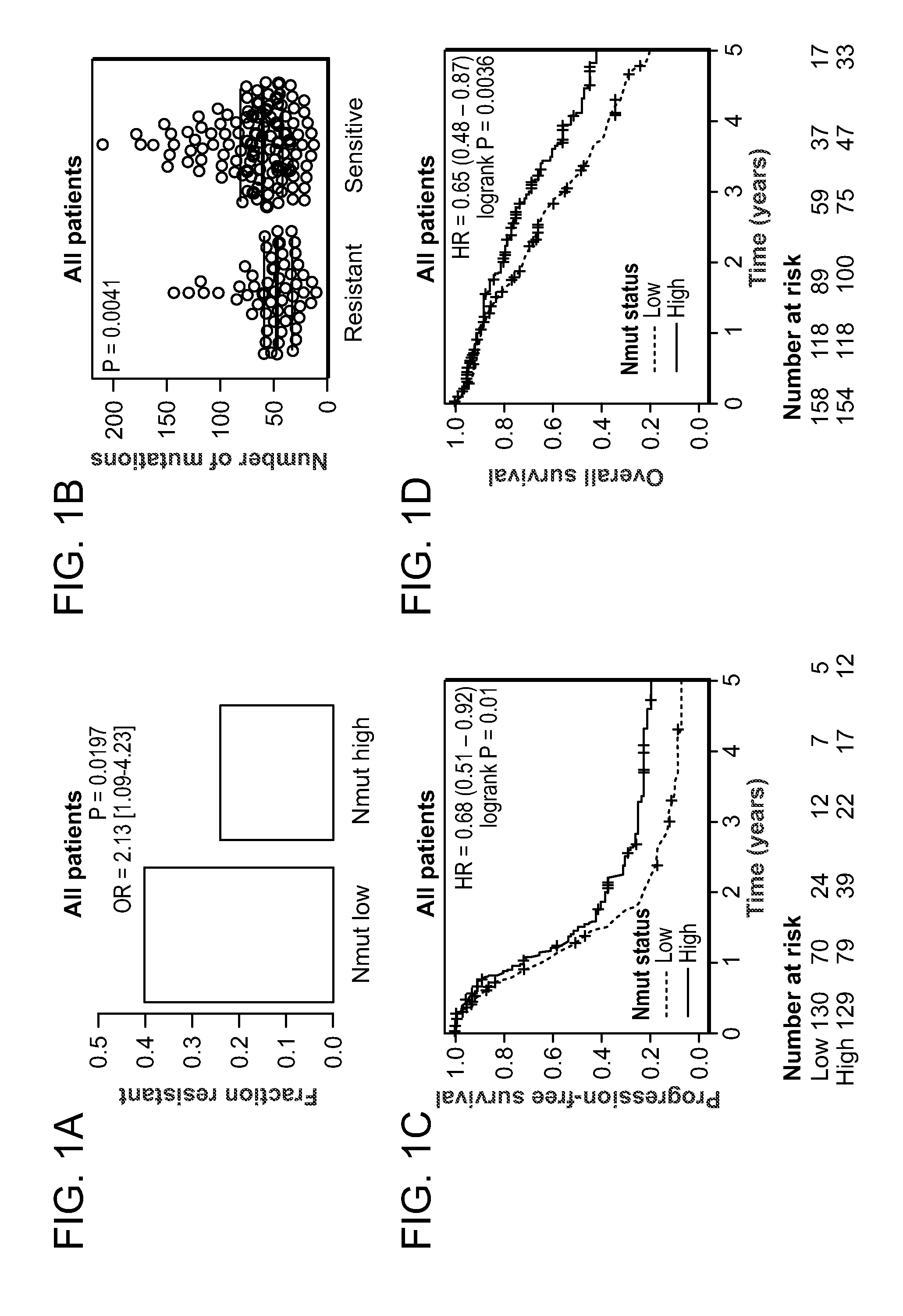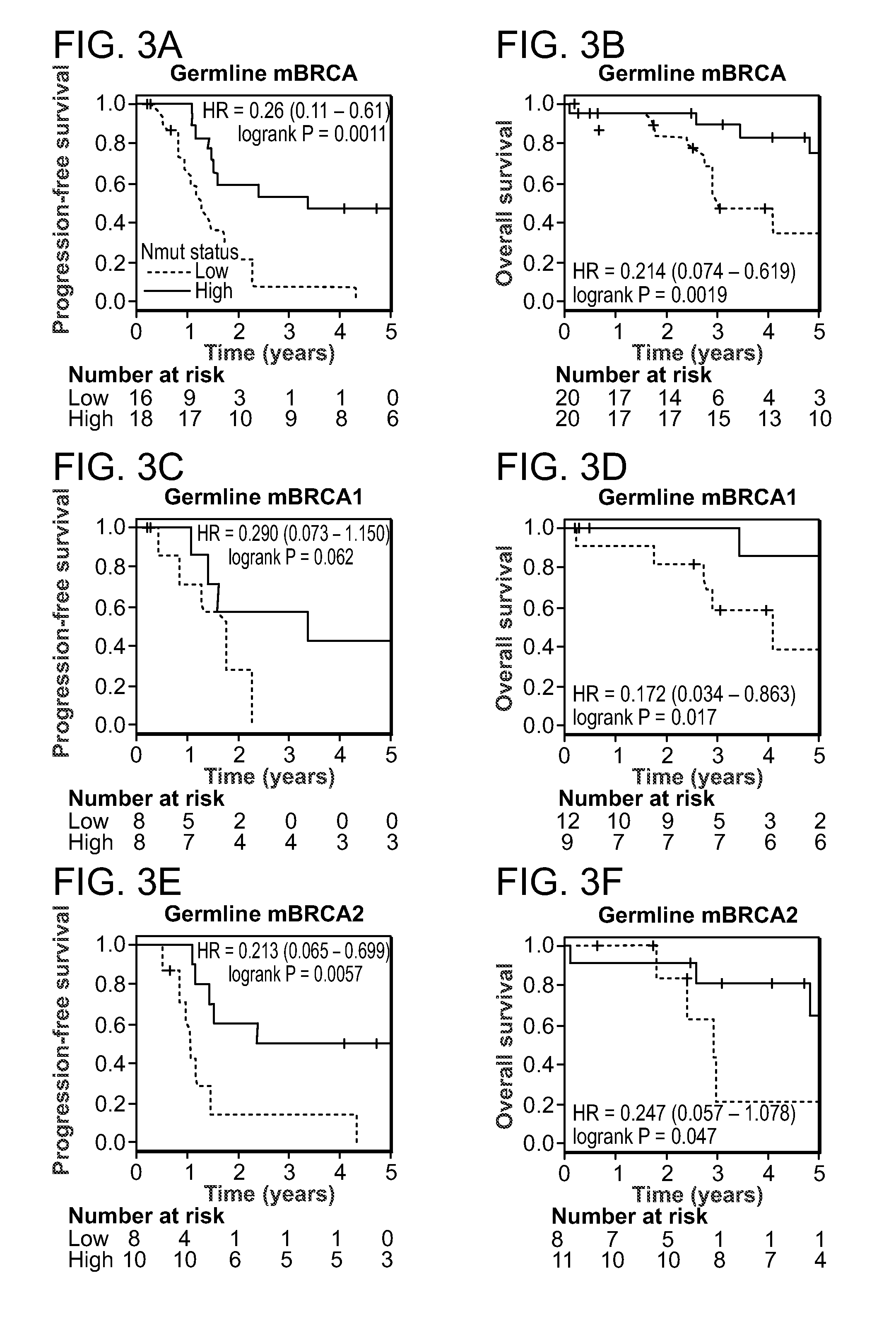Method of determining cancer prognosis
- Summary
- Abstract
- Description
- Claims
- Application Information
AI Technical Summary
Benefits of technology
Problems solved by technology
Method used
Image
Examples
example 1
General Materials and Methods
Datasets
[0089]We obtained exome sequencing data of 316 high-grade serous ovarian cancers and follow-up information from TCGA. Any sequence alteration in the ovarian tumor exome that was not present in the germline DNA sequence was called a somatic mutation and included both non-synonymous and synonymous changes. In the exome mutation data published by the TCGA consortium, a total of 19,356 somatic mutations were identified in the cohort, and most independently validated by a second assay using whole-genome amplification of a second sample from the same tumor. Mutations that were not independently validated were computationally evaluated and had a high likelihood to be true mutations as described. Based on TCGA mutation calls explained above, the total number of somatic mutations in the tumor exome (Nmut) was determined for each case (Table 2, which shows genomic and ethnic / race information of TCGA ovarian cancer cohort used in the present study.) Affymet...
example 2
Association of Mutation Burden with Chemotherapy Sensitivity and Outcome
[0092]Using data from TCGA, we found that 95% of mutations in exomes of ovarian cancer are single base substitutions. Across the TCGA cohort of 316 tumors, the number of exome mutations in individual cancers (Nmut) varies widely, from 9 to 210 (median 54.5, Table 1). To determine whether Nmut is associated with chemotherapy resistance after initial surgery, we separated patients into Nmut high and low groups based on the median Nmut of the whole cohort. A higher rate of resistance to initial chemotherapy was observed in Nmut low compared to the Nmut high group (40.2 vs. 23.9%, FIG. 1A). Nmut was lower in treatment-resistant patients than sensitive patients (median 46 vs. 59, FIG. 1B). Cox regression showed a correlation between Nmut and progression-free survival (PFS) or overall survival (OS) (P=0.013 and 0.0014, respectively, Table 1). Kaplan-Meier analysis showed a significantly longer PFS and OS in the Nmut h...
example 3
Effect of BRCA1 and BRCA2 on Mutation Burden and Outcome
[0093]Seventy patients either carried a germline BRCA1 or BRCA2 mutation or possessed tumors bearing somatic BRCA1 or BRCA2 mutations (mBRCA). We found no differences in tumor Nmut, PFS or OS between patients with germline and tumor somatic mutations in BRCA1 and BRCA2 (FIG. 5). However, mBRCA-associated tumors possessed a higher Nmut than tumors without BRCA mutations (wtBRCA; median 67.5 vs. 49.5, FIG. 6A). We separately analyzed the subset of patients bearing mBRCA and those with wtBRCA tumors, and compared tumor Nmut between chemotherapy resistant and sensitive patients. A higher tumor Nmut predicted a higher rate of response to chemotherapy after surgery in patients with mBRCA-associated tumors, but not in those with tumors that possessed only wtBRCA (FIGS. 6B and 6C). When we investigated all patients with tumors containing mBRCA, we found a significantly higher tumor Nmut in the treatment-sensitive group versus the treat...
PUM
| Property | Measurement | Unit |
|---|---|---|
| Time | aaaaa | aaaaa |
Abstract
Description
Claims
Application Information
 Login to View More
Login to View More - R&D
- Intellectual Property
- Life Sciences
- Materials
- Tech Scout
- Unparalleled Data Quality
- Higher Quality Content
- 60% Fewer Hallucinations
Browse by: Latest US Patents, China's latest patents, Technical Efficacy Thesaurus, Application Domain, Technology Topic, Popular Technical Reports.
© 2025 PatSnap. All rights reserved.Legal|Privacy policy|Modern Slavery Act Transparency Statement|Sitemap|About US| Contact US: help@patsnap.com



